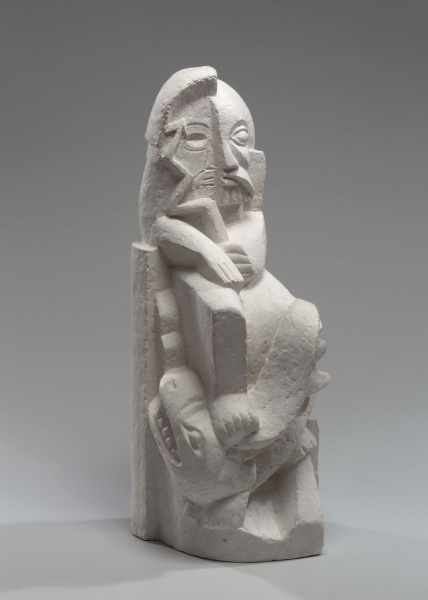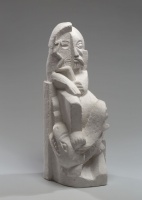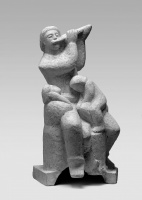

God Perkūnas
| Author: |
Juozas Mikėnas (1901–1964) |
| Created: | before 1931 |
| Material: | plaster |
| Dimensions: | 75 × 26 cm |
Juozas Mikėnas (1901–1964) was a trailblazer in modern sculpture in Lithuania, a controversial artist, renowned for his sculptural allegories of Classical forms. Works such as Christ in Distress, The First Swallows and Lithuania remain some of the most widely reproduced pieces of Lithuanian sculpture to this day. The term ‘school of Mikėnas’, originating from the Soviet era, refers to figures characterised by their Neoclassical style and recognisable type, with a robust stature, broad shoulders, a sturdy neck and a broad face, with a straight nose and an open forehead. However, this classification does not fully encapsulate his artistic range. During his formative years, particularly while he was studying in Paris, Mikėnas drew his inspiration not only from Classical art, but also from modern movements. He studied in Paris twice, in 1926 and 1927, and after a brief return to Kaunas, from 1928 to 1931, driven by the determination to attain a diploma of higher education in France. During his first stay in Paris he studied under the Post-Cubist painter and sculptor André Lhote. The sculpture God Perkūnas, exhibiting the clear influence of Cubism, probably dates from his Parisian period. Despite the complexity of its ‘broken’ form, which is typical of Cubism, the sculpture retains Mikėnas’ hallmark monumentality. Formally, it bears a resemblance to works such as Jacques Lipchitz’s The Reader from a few years earlier, or Henri Laurens’ Head of a Boxer.
Text author Jurgita Ludavičienė
Members of the Ars group tended towards emotionality, Expressionism, and an uneven texture in their work. They turned to folk art, and sought inspiration in nature. A large variety of genres appeared, and in addition to the portraits, landscapes and occasional historical paintings favoured by older artists, they began to create genre compositions, still-lifes and religious paintings. Members of the Ars group sought to develop a unique style in Lithuanian art, in order to combine the traditions of the national cultural heritage and the artistic innovations of Western Modernism. In 1932 and 1934, two exhibitions were held in Kaunas, and at the end of 1932, the Ars manifesto, the only programmatic text in the history of interwar Lithuanian art, was published.
The 1932 exhibition of work by the Ars group, the most prominent Modernist group in Lithuania, featured works made in Kaunas and Paris by the sculptor Juozas Mikėnas, the painters Antanas Gudaitis, Antanas Samuolis and Viktoras Vizgirda, and the graphic artists Vytautas Kazimieras Jonynas, Telesforas Kulakauskas and Jonas Steponavičius. Adomas Galdikas and Mstislav Dobuzhinsky, teachers at Kaunas Art School, also took part in the exhibition, in order to show their support for the young artists.
The event was accompanied by a theoretical statement of artistic principles, soon to become known as the Ars manifesto. It declared:‘Considering the current situation, we are convinced that the absence of deeper explorations in art, and the imitation of worn-out artistic forms, is killing our art. We have resolved to serve the renaissance of our homeland, and to create a style for the new era’ (ARS, Kaunas, 1932). The second Ars exhibition, held in 1934, included the same eight participants, but without Dobuzhinsky. Conservative older artists were indignant that their work was criticised by the Ars group, and themselves asked a question in the press:‘What our folk art has in common with these dumb sculptures, these pieces of canvas soiled with murky-coloured paint, these portraits with bulging eyes, crooked noses and noseless faces, we simply do not know’(‘Art and Pseudo- Primitivism’, Lietuvos aidas, 1932, No 273, p. 5). However, the visual and aesthetic principles mapped out and established by the Ars group probably had the greatest impact on the modernisation of Lithuanian art.
Text authors Dovilė Barcytė and Ieva Burbaitė
Source: Law firm Valiunas Ellex art album KAUNAS–VILNIUS / 1918–1945 (2021). Compilers and text authors Dovilė Barcytė and Ieva Burbaitė, THE ART OF MATERIALS. Compiler and text author Jurgita LudavičienėExpositions: "A Glance at the History of Lithuanian Art from Užupis", 30 August 2018 – 1 June 2019, Lithuanian Art Centre TARTLE (Užupio St. 40, Vilnius). Curator Giedrė Jankevičiūtė; "1918-1945 / Kaunas-Vilnius", 27 August 2020 – 21 August 2021, Lithuanian Art Centre TARTLE (Užupio St. 40, Vilnius). Curators Dovilė Barcytė and Ieva Burbaitė.









